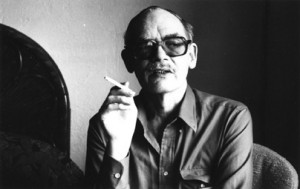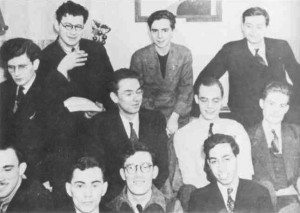Frederik Pohl, born on November 26, 1919, first published (a pseudonymous science fiction poem) in 1937 and continuously active in the science fiction world ever since, died at the age of 93 in Chicago on September 2, 2013. He was the last major figure whose career began during or before science fiction’s fabled Golden Age, that brief span of supercharged storytelling excellence which lasted from 1938 to 1946. His career in science fiction lasted seventy-six years, nearly equaling the longevity record set by his frequent collaborator, Jack Williamson (1908-2006), eleven years Fred’s senior, whose science fiction career spanned seventy-seven years.
Fred’s career was crowned with awards from both the science fiction community and the broader literary world. His 1977 novel Gateway won four major SF awards: the Hugo, Nebula, Locus, and John W. Campbell Memorial Awards. Over the span of his career, his works received four Hugo Awards, three Nebula Awards, and two John W. Campbell Memorial Awards. He won the National Book Award for his 1979 novel, Jem. He became the twelfth recipient of the Damon Knight Memorial Grand Master Award in 1993. In 1998, he was inducted into the Science Fiction and Fantasy Hall of Fame. He won his final Hugo Award, granted him in 2010, was (oh-so-fittingly, given his history and roots) in the category Best Fan Writer; he won for his work on his blog, The Way the Future Blogs.
Even given his tremendous output of more than sixty-five novels and thirty short story collections, I would venture that Fred’s greatest contribution to the field of science fiction was as one of the prime architects of its infrastructure. Today’s reality of science fiction as a thriving literary and commercial realm spanning print, film, television, comics, role-playing games, and virtually every other form of popular media would, in all likelihood, never have come into being without the pioneering work Fred performed, both as a fan and as a professional, during the 1930s, 1940s, and 1950s. Had Fred and his fellow Futurians (who included Isaac Asimov, Cyril Kornbluth, Judith Merril, Donald Wollheim, and James Blish, among others) not created such a vibrant, resilient, attractive, a creatively fertile fan culture in the late 1930s and early 1940s, science fiction as a distinct commercial and literary endeavor probably would have perished in the second half of the 1950s with the death of the pulp magazine industry.
Although the literary roots of science fiction go back at least as far as Mary Shelley’s Frankenstein, or, The Modern Prometheus (1818), its establishment as a distinct commercial literary genre did not occur until a little more than a century later, with the publication of the first issue of Hugo Gernsback’s Amazing Stories in April, 1926. At the height of the science fiction pulp magazine boom, in the early 1950s, more than sixty SF pulp magazines were being published monthly or bimonthly, allowing dozens of professional writers to make their livings solely or primarily from writing science fiction. However, the boom was followed shortly thereafter by a bust. The demise of the American News Company, the nation’s largest magazine distributor, in 1957 kicked off a chain of adverse circumstances which killed off the majority of the pulps. By 1959, the number of science fiction magazines had shrunk to a bare half-dozen, one-tenth the number of magazines which had been published at the height of the boom. Many professional writers, unable to make enough sales in the severely constricted market, stopped writing science fiction altogether. Some returned to the field in the mid-1960s, when the growth of the markets for paperback original fiction, both novel-length and short fiction, breathed new life into the field. Many, however, abandoned the field forever.
Several once-thriving popular fiction genres did not survive the death of the pulps, or only survived in an extremely attenuated form. Nurse stories, air-war stories, and knightly adventure stories went the way of the buggy whip. Westerns, once enormously popular, nearly disappeared from the marketplace. Yet science fiction survived its near-death experience, to emerge, in the late 1970s, as one of the most dependable and widely popular of the genres of commercial fiction, surpassed in popularity and sales only by romances and mysteries (and, if one takes into account its impact through wider media, science fiction might be said to have leapfrogged those rival genres in influence and popularity).
Fred Pohl had an awful lot to do with this.
Fred and his fellow Futurians basically established the notion of a farm team for science fiction. He established the paradigm of fans (short for “fanatics,” remember) developing their creative chops by writing and editing fanzines, then transitioning into paying, professional markets. Fred himself laid the groundwork by accomplishing this feat amazingly quickly. With only one professional sale under his belt at the time (the poem, “Elegy for a Dead Satellite: Luna,” published in the October, 1937 issue of Amazing Stories), Fred snagged a position as editor of two lower-rung science fiction pulps, Astonishing Stories and Super Science Stories, in 1939, a position he held until 1943, when he was inducted into the U.S. Army. As editor, he purchased the earliest stories of many of his fellow Futurians (and some of his own, but always under pseudonyms). Even earlier, in 1937, he began a side career as a literary agent, helping launch the careers of many prominent science fiction writers, most notably Isaac Asimov, securing the sale of Asimov’s first novel, Pebble in the Sky, in 1950. Fred went on to become editor of two far more prominent science fiction magazines, Galaxy Science Fiction and Worlds of If, from the late 1950s to 1969; during his tenure, If won the Hugo for Best Professional Magazine three years in a row, from 1966 to 1968.
That fan-to-pro progression was key to the science fiction field’s survival and eventual resurgence following the Great Pulp Magazine Die-Off of the late 1950s. Fans didn’t merely read or write science fiction; they believed in it, they lived it, they clutched it to their breasts as a form of religious faith. Only practitioners with that sort of passion for the field and its possibilities could weather an almost complete disappearance of income from their chosen area of endeavor for five to seven years, keeping themselves afloat with other forms of work during the lean years between 1958 and the mid-1960s, when the paperback market began filling up the vacuum left by the death of the pulps. Only writers with an abiding faith in science fiction would dare attempt a career in SF publishing after the flame-outs of so many of their predecessors in the late 1950s. Fred never left the field. Even during its darkest days, he kept the flag of science fiction flying.
The Futurians had their counterparts on the West Coast, in Los Angeles. Ray Bradbury, Forrest Ackerman, Ray Harryhausen all began their careers as fans in the late 1930s and went on to major accomplishments in the areas of fiction writing (Bradbury), magazine publishing (Ackerman), and filmmaking (Harryhausen). Many notable science fiction writers who began their careers during the decades following the Golden Age mimicked Fred’s trajectory from young fan to young pro. Robert Silverberg, Harlan Ellison, and Michael Moorcock all made the transition from fan to pro during their teen years. Silverberg began his career in the late pulp era as one of the youngest and most prolific new writers of the mid-1950s. He weathered the near-disappearance of his science fiction markets in the late 1950s and early 1960s by writing best-selling history popularizations, then returned to science fiction in the mid-1960s as a trendsetter of science fiction’s New Wave, publishing a series of novels which became enduring classics. Moorcock emulated Fred’s feat of becoming a teenaged pro editor by becoming editor of Tarzan Adventures at the tender age of 17; he later took over the reins of Britain’s nearly moribund New Worlds science fiction magazine, making that periodical a focal point of the New Wave, publishing stories by J. G. Ballard, John Brunner, Brian Aldiss, and Thomas Disch.
Fred Pohl did not shape the future of science fiction only through his early work as an editor and literary agent and his establishment of the fan-to-pro career path paradigm. He, along with his friend and frequent collaborator Cyril Kornbluth, broadened the fields of scientific endeavors extrapolated by science fiction to include the “softer sciences,” fields such as sociology, psychology, anthropology, and economics. Their collaborative novel, The Space Merchants (1953) (first published in shorter form as “Gravy Planet” in 1952 in Galaxy Science Fiction), is a key document, the earliest extrapolation of the field of advertising in science fiction; it blazed a trail which led to the enormously influential novels of Philip K. Dick and to much of the work of the writers associated with the New Wave.
Up until the mid-1970s, Fred produced the majority of his fiction in collaboration, most frequently with Cyril Kornbluth and Jack Williamson. However, he experienced a major career resurgence in 1976 with the publication of Man Plus, winner of that year’s Nebula Award for Best Novel, and a new pinnacle in maturity and power for his solo fiction. Following this book, he went from strength to strength, publishing award-winners or nominees Gateway (1977), Jem (1979), Beyond the Blue Event Horizon (1980), and The Years of the City (1984). Following the mid-1970s, when he got his “second wind,” Fred published forty-five novels and story collections – an incredible total for what was essentially a second career, following his first career from the late 1930s to the early 1970s, and certainly an inspiration for any writer feeling fatigued after “only” thirty-five years of work.
As if all these accomplishments weren’t enough, Fred also wrote one of the most readable and fascinating of the memoirs of a life spent in science fiction, The Way the Future Was (1978). This is a must-read, not merely for students and fans of the science fiction field, but also for anyone interested in the history of the Great Depression, of New York City in the 1930s and 1940s, and of the growth (and near-demise) of the American Communist Party during the years leading up to World War Two.
Regarding the first half of Fred’s amazing career, I wrote a seven-part series on his partnership and collaboration with Cyril Kornbluth (that series of articles begins here). Using all available sources, comparing various versions of their novels (oftentimes, shorter versions were published first in one of the magazines, usually Galaxy, and were later expanded for book publication), I attempted to unravel the strands of their collaboration, to determine which of the two contributed which ideas, characterizations, and plot developments. I was curious to find out how close to the mark I’d come, so I emailed links to my articles to the only man who could provide confirmation of my theories – Fred Pohl himself. I was extremely gratified to receive return correspondence, in which Fred praised the work I’d done and suggested that I collect the articles into a short ebook (which I just may do one of these days).
Rest in peace, Fred. You were a giant in so many ways, and all of us who labor in the field of science fiction (and its many offshoots) owe you an immeasurable debt of gratitude.






